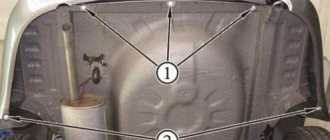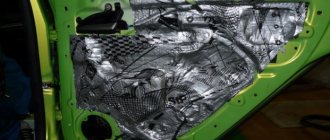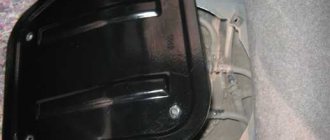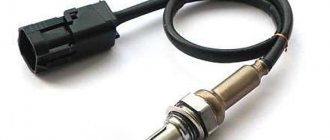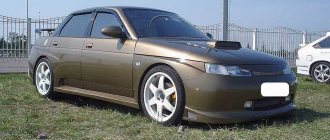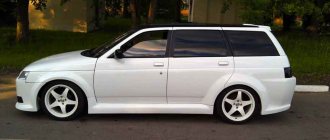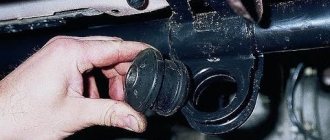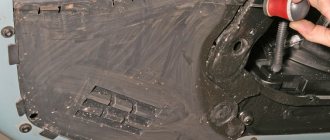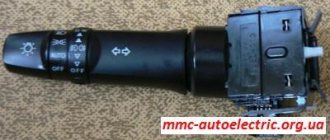Elegant VAZ model
Most of our citizens want, if not luxury, then basic comfort when moving. Car manufacturers sometimes forget about sound insulation, giving preference to interior or exterior improvements. The Lada Granta passenger car, which is quite good in quality, also does not have good noise protection.
If the owner of a Lada Granta wants to make long trips in a comfortable and quiet interior, he needs to resort to such car tuning as additional sound insulation. This simple operation will allow you to get rid of several sources of unpleasant sounds at once. We are talking about noise from the engine, from the road and internal creaks in the cabin.
If a car enthusiast has certain skills in working with the necessary materials and tools, then the procedure for eliminating extraneous sounds in the car can be done with your own hands. In addition, if you use a reliable Shumka when tuning the body, it becomes possible to significantly increase the protection of your Lada from corrosion.
Materials and tools
Body soundproofing material
In order to carry out acoustic tuning with your own hands, you will need tools that are found in the trunk of almost every passenger car: a jack and a set of keys. In addition, you will need:
- hair dryer;
- knife;
- scissors;
- dense roller;
- sandpaper;
- solvent.
While the list of tools is relatively small, the list of materials that can be used to protect a car from extraneous noise is quite extensive.
Soundproofing Lada involves the use of the following materials.
- Vibration isolators designed to reduce vibration from the main components of the machine - engine, wheels and gearbox.
- Sound insulators that have the ability to reflect external sound waves, preventing them from entering the car interior.
- Sound absorbers, which due to their structure almost completely absorb sounds.
- Anti-squeaks designed to eliminate the characteristic sounds produced by rubbing or contacting parts.
A wide range of such materials are available for sale to improve the acoustic qualities of the interior.
Manufacturers' recommendations (different methods)
Installation diagrams for trunk sound insulation with materials:
StP Aero Plus (3mm)
Bimast Bomb Premium (4.2mm)
Shumoff Mix F (6.2mm)
Accent Premium (8-10mm)
Approximate price of materials (depending on body type):
- Budget option (2 layers, thin vibration damper and heat insulator), up to 2,500 rubles.
- Popular option (2 layers, vibration damper and sound absorber), about 3,000 rubles.
- Maximum effect (3 layers of vibration damper, sound absorber and sound insulator), more than 3,000 rubles.
Interior noise protection
Work in the cabin involves soundproofing the wall of the engine compartment, rear parcel shelf and doors. In addition, you can treat the glove compartment panels with anti-squeak yourself. Car doors have the largest surface area that can be subjected to acoustic tuning in the cabin.
Soundproofing doors begins with disassembling them. After removing the trim, the entire surface of the door is cleaned of dirt and degreased. Next, two sheets of vibration absorber are glued overlapping. A layer of sound-absorbing material is glued onto them, and an anti-creaking sheet is placed on top of it. Rubbing parts and holes for them are covered with anti-squeak. The plastic trim is covered with a vibration isolator, and the door opening handle is covered with anti-creaking. After this, you assemble the door yourself. The sound insulation of the remaining doors of the Lada Grant is similarly arranged.
The interior floor can be covered with layers of vibration-insulating and noise-absorbing materials. Particular attention should be paid to the absence of cracks. Soundproofing the trunk shelf is necessary not only to get rid of rattling parts and noise from the luggage compartment. It is important for improving the sound quality of a speaker system that is mounted on a shelf. This work begins with dismantling the shelf. After this, layers of vibration absorber and noise absorber are successively applied to the product.
Anti-creaking is glued in places where the shelf touches the side platforms. The wall of the engine compartment is covered first with vibration and then with noise absorber. The moving parts of the pedals are covered with a material that eliminates squeaks.
Algorithm for carrying out noise insulation work
First of all, Granta Liftback doors are soundproofed. This is explained by the fact that the main cause of noise lies precisely in them. Even if this work does not bring results and you have to continue installing the Shumka further, the cabin will become much quieter.
Before gluing, the sound insulation should be heated with a hairdryer, applied to the area to be glued and smoothed with a roller or other method. This will allow the material to take shape, literally merge with the surface being treated, repeating all its curves, which will improve noise absorption.
Conclusion Installing sound insulation yourself is not such a difficult job. Why overpay? Hone your skills on your car, maybe this will become your additional income in the future? There are a lot of people willing!
Body sound insulation
This stage of work includes processing the underbody of the car and wheel arches. In cars that have not undergone acoustic tuning of the body, long-distance trips are quite tiring, both for the driver and passengers. The underbody, not protected by soundproofing materials, transmits all road noise into the cabin like a giant membrane.
The bottom of the machine can be treated with either liquid material or sheet material. Before processing begins, the wheels and fender liners are removed from the car, the entire bottom and wheel arches are thoroughly cleaned of dirt and degreased. The bitumen-based vibration insulator is applied by painting surfaces in several layers. This will protect the lower part of the body not only from noise, but also from corrosion. In addition, this layer will protect the bottom from damage when stones get into it from under the wheels.
Speaking of masters...
Two people worked: an older man (in the photo with glasses) and a young guy. It was very interesting to watch how they performed the same job in very different ways (on the right and left of the car). For example, when gluing the floor began, the older one glued the material in small pieces. But the young man tried to paste the entire sheet of material at once. And, of course, the first one was more dexterous... Experience, sir...
In general, well done guys! I am a professional in several fields myself and love to see how other professionals work. Liked! Thanks to them!!!
Covering car doors with soundproofing materials
Now let's look at the process of soundproofing doors in a Lada Granta car in more detail. To do this yourself, you need the following materials and tools:
- set of acoustic plugs for cars;
- 5 sheets of 3 millimeters each of “Vibroplast” Gold or Aero;
- 2-3 sheets of “Bitoplast” 10 millimeters;
- pistons;
- rubber roller;
- alcohol;
- corrugated pipe;
- protective gloves;
- knife;
- screwdrivers and keys.
Having prepared the Lada Granta car and the necessary equipment, you can begin to work. First you need to remove the trim from the car doors.
Step 1
Step 2
To do this, remove all the plugs by prying them up and unscrewing the screws. By snapping the pistons off the bottom edge, you need to pull off the covering material. Then, you should unscrew the columns and remove the dirt-proof films. Next, you need to treat the work surface with a degreaser, for example, alcohol, to remove dirt and dust. Then you need to smooth out the old vibration-isolating pad or glue a new one. Remember to wear gloves to avoid possible cuts and burns.
Step 3
Next you need to cut the material. Noise insulation is best achieved with the Vibroplast Gold/Aero vibration absorber. It needs to be cut into pieces of approximately 10 by 15 centimeters or strips. On the foil side, each element should be heated with a hairdryer to a certain state in order to prepare it for use.
You need to remove the paper from the molten piece, push it through the technological windows and stick the skins onto the metal, leveling it with a roller. Such maneuvers must be performed for each door of the Lada Granta car.
Step 5
At the next stage, you seal the technological holes with your own hands with vibration-proofing material. But before this, the wires should be secured by putting a corrugated pipe on them.
Let's get to work...
STP brand materials were used
:
- The first layer is vibration-absorbing material GB with a thickness of 3 mm;
- The second layer is the noise-absorbing “Barrier KS” (4 mm);
- The third layer (“wish” on the front wheel arches) is Noise Block (2 mm).
From left to right: GD, Noise Block and Barrier KS.
I will say right away that the thicker the material, the better. But I chose the most budget. True, the result is quite significant (more on that later), but if the means allow, then it is better to put a thicker second layer.
And this is not only my personal knowledge of physics, but also the conclusions of Shumka tests by the Za Rulem magazine somewhere in the mid-90s - I remember that article. Everything there is linked to the number of surfaces that sound encounters on its path. In thick material, in its numerous layers and bubbles, there are more such surfaces! It will take a long time to explain, but know: thicker is better!
Please note that the “vibration” is not glued to the stiffeners, but only to the “area” elements - they are the ones most vibration-loaded. Those.
Please note: Review of Volkswagen cross up! .
There’s no need to blow the minds of the craftsmen if they vibration-isolate the way I do, and not every inch, whether it’s needed or not, it won’t do any good.
But be sure to check this: it is the “vibration” that needs to be rolled in forcefully with rollers like these. Just don’t try to demand from the craftsmen that they roll out the second layer as well - the whole point of the noise will be immediately lost. The second layer is simply applied “by hand”!!!
One of my “wishes” was that the craftsmen would make noise and the “podium” on which the passenger sofa lies. According to the original “plan”, i.e. the one that costs 8,000 rubles, Shumka only reaches this podium and rises to the top. That's all. I asked to cover everything up to the backs of the seats.
The second layer completely repeats the first. Everything looks like this, but let me remind you that if funds allow, then do not be greedy for thicker Shumka, at least in the area of the arches and along the central tunnel (the muffler runs below there). True, problems may arise with laying the floor covering, but here you need to find a balance or insist on your own!
In the photo above, I show you the second “wish” - increased noise in the arches and partially in the front shield. A thin Noise Block is pasted here. According to the masters, it gives an effect. This is probably true, but I have very noisy stock Pirelli Cinturato P1
and this Noise doesn’t even save you from it. But still, the roar of rubber is now noticeably less audible.
However, we must take into account that my wheels are a little overinflated. Instead of the required 2 “points” I pumped up 2.3 (+15%). This is a “cargo” habit I have, which appeared after two explosions. *
wheels on MAN and Gazelle. Overinflated wheels are hard and make more noise.
*
—
Only under-inflated wheels explode due to overheating.
.
The old factory Shumka is put back on top of the one made. This is normal and saves us money. You can, of course, demand that a thick Shumka be rolled up instead, but... Mani, mani...
Sound insulation of fender liner and hood
Excellent sound insulation does not only mean treating the door with a vibration absorber yourself. It’s also worth covering the car’s fender liners with materials. The tools and resources needed are the same as in the previous case. The car must be placed on a jack and the wheel removed. Then you should carefully remove the fender liner from the arch and clean it. The surface must be washed and degreased. Then cut the Vibroplast into pieces and apply it to the part so that you know where and what to glue. Next, these pieces are heated with a hairdryer and attached to the fender liner. It is necessary to treat at least 70% of the area of the fender liner for greater effectiveness. Use a roller to level the Vibroplast and install the fender liner in place.
To quiet the space in the hood area, maneuvers similar to those described above are performed. Having degreased the surface, the already heated soundproofing material is applied and glued, leveling it with a roller. A sheet of Bitoplast is glued to the inside of the hood and secured with pistons. This ensures sound insulation of the engine, the sounds of which are now heard less into the cabin, thanks to the treatment of the hood.
So, now your Lada Granta car has become more advanced. With your own hands you isolated the areas of the car's door, hood and fender liner. There are no extraneous sounds or rattling rods, plastic rattles or unpleasant squeaks in the cabin. And now the doors open easily, silently, like in an expensive foreign car. Even the music began to sound more pleasant and clearer. Thanks to the work done yourself, your car has become an order of magnitude better and has found a new life.
Sound insulation of a budget class car is carried out according to the principle of reasonable sufficiency. If you want something more from your Lada, you need to improve it. For the soundproofing of a Lada Granta car by hired craftsmen, you have to pay about 20 thousand rubles, and a Shumka made by yourself will cost 2-3 times less. From 7 to 9 thousand rubles is enough to purchase materials. Noise reduction is achieved through three main strategies.
- Reducing secondary vibrations from metal body panels.
- Suppression of aerodynamic noise and sounds generated by wheel rolling, operation of vehicle components and assemblies, as well as external sounds.
- Fighting "crickets".
Let's talk more about money
Even my youngest daughter told me that “why should I buy a new car and then finish it up?” Alas, she didn’t know that a car that was more or less decent in terms of sound insulation (station wagon) was another 350 thousand, no less - LADA Vesta SW Cross. And here, even if I suddenly order a full Shumka, everything will cost me 26 thousand (plus “wishes”).
I didn’t order full sound insulation, but only ordered floor insulation for 8,000 rubles. Along the way, “wishes” arose, which were valued by the craftsmen at another 2,000 rubles - I agreed and they did everything!
Beginning of work…
Tools and materials
To perform work on dismantling the car interior and applying materials, you can get by with standard tools, but it is better to purchase some specific equipment. List of tools:
- Screwdriver Set;
- wrenches and sockets;
- a set of plastic grips and spatulas for disassembling the car interior;
- narrow stitching roller made of plastic or hard rubber;
- protective gloves.
The use of modern self-adhesive materials allows you to do without a hair dryer. To improve elasticity, vibration insulation sheets can be laid out in the sun before pasting. List of materials:
- rags;
- sponges;
- solvent;
- vibration isolation sheets;
- sound insulation sheets;
- cushioning material;
- plastic clamps;
- soundproofing mastic.
As a solvent, in order not to suffer too much from the pungent odor, it is better to use white spirit.
How to make your own trunk soundproofing
Preparatory work : remove the trunk trim, clean and degrease the metal surface (White Spirit).
The procedure for installing sound insulation (using the example of Lada Vesta):
1st layer: heat the vibration damper with a construction hairdryer and glue it to the trunk floor, butt to butt. Roll with a hard roller. We glue a thicker vibration damper (Bimast Bomb Premium or Shumoff Mix F) onto the wheel arches. We cover 100% of the area.
The trunk lid can also be covered with a vibration damper.
2nd layer: glue sound-absorbing or heat-insulating material with a continuous carpet. There should be no gaps. As a rule, Accent is placed on the trunk floor, and Biplast is placed on the arches (it better follows the rounded shape).
3rd layer (optional): apply a soundproofing membrane to 100% of the surface. The third layer is installed on the trunk floor in rare cases.
Reassemble in reverse order. The whole process will take about 3 hours.
Video example of installing trunk sound insulation on a Lada Granta:
Application rules
To remove interior parts, all visible screws are unscrewed. The element is pryed off from one edge and then along the entire perimeter to snap off the plastic or metal clips. To remove load-bearing elements such as seats or seat belts, you have to use wrenches and sockets. The surface to be treated is thoroughly cleaned of dirt and anti-corrosion coatings, dried and degreased.
Many people strive to cover the entire surface of the metal with vibration insulation. This is a pointless waste of time and expensive material. It is necessary to paste over extended flat surfaces that are capable of resonating. By default, 70% of the surface is covered. Never seal service or ventilation openings. They allow moisture to escape and air to circulate. The plugs must be left open; they will be needed to perform technological operations.
What the disassembly showed...
Disassembly showed that AvtoVAZ has a so-so attitude to sound insulation of its budget cars. Well, noise in the form of felt-loose mats cannot be considered serious. Is it really the same noise on Vesta?
After the “opening,” two interesting points emerged:
1. The felt “sound insulation” under the driver and front passenger is not at all the same as under the rear passengers - it is thinner and the material is slightly different (at least on my car)…
2. While studying the issue of sound insulation, I often came across information that there is no... vibration insulation under the driver! There is something underneath everyone, but let the driver feel the road with his feet, otherwise what kind of driver is he then? :)) So it was on my car! This surprised me very much...
I also discovered an interesting and funny solution: a foam plastic foot rest for the front passenger - I’ve never seen anything like this and no matter how AvtoVAZ know-how it was (the vocational school students were frolicking in practice again?)…
However, Chinese automakers compete very successfully with our AvtoVAZ using “bypass” technologies - I personally saw a Shumka made of sand
(!!!) sewn into fabric mats, similar to how we sew quilted jackets... I think it was Chery Amulet... :))
Comparison of treatment zones
There are zones that can be processed independently of the others:
- doors;
- wheel arches;
- trunk;
- salon floor;
- front panel;
- ceiling.
The treatment of Lada Granta doors and wheel arches provides the most noticeable effect. After finishing, doors become heavier, close more clearly and with a more noble sound. Sound insulation of doors cuts off street sounds, road debris reaching the outer surface can no longer be heard, and acoustics begin to sound differently. The wheel arch treatment combats the sound of tires rolling.
The intensity of the sound from pebbles flying along the arches and streams of water from under the wheels is reduced. When installing a powerful audio system, ceiling insulation becomes important. Without connection to quality music, the ceiling is not an important area. Soundproofing materials only show themselves here when it rains. In the trunk area, it is necessary to suppress the noise of the exhaust system. This area becomes especially important when installing powerful speakers in the luggage rack and a subwoofer in the trunk.
Soundproofing the cabin floor muffles engine and transmission noise. These sounds largely reach the vehicle's interior by being reflected from the road surface. In the front panel you have to fight with “crickets”. In general, this is limited to pasting sealant on the joints of parts, rods, wiring and pulling all fasteners.
Even the most complete sound insulation rarely gives a 100 percent result. Difficult-to-eradicate “crickets” become especially noticeable against the backdrop of a general reduction in noise. You need to be prepared for this when deciding on such long and painstaking work.
What is the harm of noise?
First of all, this concept includes all useless sounds that have negative properties. So they are:
- reduce the driver’s reaction speed, and as a result he spends more time making a decision;
- irritate the nervous system;
- may harm the normal functioning of some organs;
- distract from the driving process, etc.
Constant noise comes from:
- running engine;
- transmissions;
- wheel arches.
In addition, sometimes additional noise occurs due to a malfunction of the heating system or air conditioner.
And finally, poorly secured interior elements often irritate with creaking or crackling noises.
